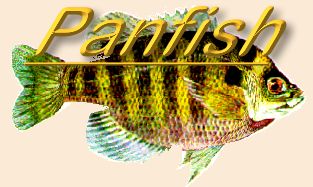|
Most of us have moved from our "home waters"
to a new area. We no longer have the intimate
knowledge of every tree root, sandbar, rock,
fallen log, and "hidey hole" of your favorite
fish. But, fish are fish, and fishing is fishing,
no matter where the location, right?
A couple of years ago I lived on a great fishing
river in north eastern Iowa. The river, about 100
feet from my front door, was pretty typical for
the Midwest. Dark, clouded water, slow moving and
shallow in the wide areas and deep and full of
currents in the narrows. It was home to crappie,
blue gills, walleye, northern and the full assortment
of bottom feeders. For the most part, fishing it
was easy; find the cover or forage and you found
fish. Couple that with watching the local insects,
selecting a good look-alike from your fly box, and
you were on your way to a heaping platter of fish.
Then I moved to northwest Iowa, an area known as
"The Iowa Great Lakes." I soon found out just how
little I knew about fishing. The lakes here are all
natural, left over from the glacial age. West Okoboji
is almost entirely spring fed and, according to National
Geographic, one of only three "Blue Water Lakes" in the
world. It's deep, up to 120 feet, cold, and clear, year
round. West Okoboji feeds into East Okoboji, which feeds
into Upper Gar, which feeds to Minnewashta, then into
Lower Gar, which empties into what becomes the Little
Sioux River. All of the lakes are interconnected and
navigable. I'm able to fish all of them from a boat
without ever having to leave the water. Also, each
lake gets shallower and more turbid and each one has
its own characteristics, environmental and biological
cycles. Now throw in the fact that I'm talking about
a couple of thousand acres of water which hold several
types of blue gill, black and white crappie, large and
small mouth bass (plus that incongruent thing called a
"Wiper - a hybrid cross between a white bass and a
striper), perch, walleye, northern, and musky and you
can start to see my dilemma. You also have to toss in
a few other factors, such as: these lakes have little
or no current, the temperatures between the lakes vary
up to 10 degrees because of the varying depths and
turbidity of the water, and, because of those factors,
the insect hatches on each of the lakes is different.
Then there's one last factor to figure in, almost a
coup de grace: almost no one in the area fly fishes.
There's every other type of fisherman on earth here
from down rigging trolling behind 20' deep hulled
boats powered with 220 horse motors to the cane pole,
bobber and worm angler of yesteryear, but the fly
fisher is almost never seen.
So, how do you convert a river angler to a lake
angler on waters that normally see bait casters
loaded with 20 pound test line and enough
professional tournament fishing to make Babe
Winkleman slobber? You may be surprised to learn
that for the first season I put away my fly tackle
and long rods and "fished with the crowds." I
trolled, I jigged, and I even learned what a bottom
bouncer was and how to rig one. I kept telling myself
that "what the heck, it's still fishing..." But I was
also making a lot of mental notes, like where the
fish were, what type of structure they were relating
to, what lures, rigs and jigs they were attracted to
and what colors worked or didn't work. I kept a
fishing log and marked up the lake maps I'd bought
with dates of catches, weather data, and dates of
insect hatches.
Over the winter, while working on a walleye or bass
rod for one of the locals someone would notice my
collection fly rods or my fly tying gear and ask
what they were for. I'd just tell them that I'd
rather show them some day. They'd usually snicker
and tell me that the nearest trout stream was about
150 miles in either direction and they weren't "into
trout." I'd just smile and nod my head, finish their
rod and hand them the bill. Don't get me wrong, I
enjoy fishing by what ever means and own about 45
rod and reel set ups for everything from salt water
to creek water. But I love fly fishing. The feel of
the reel against your palm while the fish is making
its run and the bend in the rod while it tests its
strength against the fish is so much more exciting
than tightening the drag and cranking it in.
By spring I was ready. I'd tied a bunch of new flies,
cleaned my lines, rods and reels. Checked all my gear
over too many times and waited for the snow to melt
and the ice to clear. The phone rang one Saturday
morning with a fishing buddy on the other end.
"The gills are biting over in Emerson Bay, want
to come along?" he questioned. I supplied an excuse
about needing to get something done around the house
and thanked him for the offer. As soon as I hung up
I grabbed my fly gear, vest, waders and hat and headed
for Emerson Bay. I had a blast! I released a bunch
of fish that day, keeping only enough to refresh my
taste buds of what fresh fish tasted like instead of
the frozen ones from last fall we'd been getting out
of the freezer for the last couple of months.
As different areas of the lake system became more
active and different species started into their
pre-spawn routine of "beefing up" I started ranging
out farther and using my pontoon as a casting
platform. I was catching a larger variety of fish
then I ever had on the river and having a lot of
fun doing it.
Then one Saturday morning, as I was taking a 1-pound
crappie off a bright colored "mini-popper" a boat
pulled along side mine. In it were three of my
fishing buddies...Busted...big time! "So, uh,
how's it going guys?" I asked sheepishly. "So-so"
was the cool reply. "How 'bout you?" they parried.
"Can't complain," I said cautiously. "Want to tie
on and have some coffee and a doughnut?" I asked.
They all looked at each other as if they were afraid
that one would call the other a sissy if they said
yes. I calmly poured another cup of hot coffee from
my thermos, looked over at them and said, "Got plenty
of it and I think I have a couple of extra cups..."
One finally said that they thought they should get
going, another said he thought a cup of hot coffee
sounded pretty good and the third agreed with him.
They tied their 18 foot, "V" bottom to the side of
my pontoon and came on board. I divided up the last
of the coffee and sat down at the table and opened
the box of doughnuts and passed them around.
"So, you're fly fishing, huh?" the first one said as if it
were a dirty word. I simply nodded and bit into a
doughnut. He indicated with his head towards the
live well where he'd seen me drop the big crappie
into and said, "Mind if I take a look?" I shrugged,
indicating that I didn't care. He opened the well,
his eyes got as big as the doughnut in his hand.
He turned back to the others and announced, "He
ain't fishin', he's catchin'! Take a look!" The
other two darn near jumped towards the live well,
forgetting to act nonchalant. "So, what kind of
bait are you using?" one asked. I showed them the
little popper on the end of my tippet, its feathers
looking pretty bedraggled after taking nearly 20
fish. "Just how does this long stick operate?" one
of them asked. I gave him a quick demonstration
and handed the rod to him. I immediately knew
that I had at least one convert on my boat, within
the next hour there'd be two more.
Sometimes adjusting to a new area and learning
new techniques takes some time. Other times you
can find a local that can teach you the ropes
and cut down on the learning curve. In my case,
I had to go "backwards" in order to go forwards.
I still go fishing with the guys using the "other
rigs" but I still go back to my first love, fly
fishing, as often as I can, and I have to admit,
I'm starting to see more and more fly anglers
around the lakes.
~ Randy Fratzke fritzfratz@mchsi.com
|



